Consolidation Reference Manual
You can still refer to the Consolidation reference manual for consolidation information that has not been impacted by changes in the legislation.
C10 MEC groups
C10-2 Worked example
Losses
C10-2-325 MEC groups and losses - determining whether the focal company satisfies the continuity of ownership test
Description
The head company of a MEC group that is seeking to utilise a loss transferred to it from another company in the group is known as the focal company. It is considered to have satisfied the continuity of ownership test (COT) if the company defined as the test company satisfies that test based on certain assumptions outlined in this example.
This example shows how the test company is identified and explains the application of the COT to MEC groups. The example relates specifically to two different losses transferred to the head company of a MEC group under Subdivision 707-A of the Income Tax Assessment Act 1997 (ITAA 1997):
- •
- a loss transferred as a COT transfer, [1] and
- •
- a loss transfer that is not a COT transfer.
Commentary
In recognition of the special characteristics of MEC groups, Subdivision 719-F of the ITAA 1997 modifies the rules about transferring and utilising losses within those groups. It also covers the application of the COT under section 165-12 of the ITAA 1997, which helps to establish whether a loss can be utilised. These special rules apply (with one exception) when the focal company is the head company of a MEC group at any time in its ownership test period. [2]
The focal company is considered to have made the loss because either:
- •
- the loss was transferred to it under Subdivision 707-A, or
- •
- the loss is a group loss (i.e. it was generated by a consolidated group or MEC group headed by the focal company).
The focal company is considered to meet the conditions in section 165-12 if the test company, as determined by section 719-265, would meet those conditions based on the assumptions in sections 719-270, 719-275 and 719-280.
In order to apply the COT to the test company, it is necessary to assume that the test company made the loss, even if it actually did not (e.g. because the test company is also the top company).
The COT is applied to the test company for the period from the start of the test company's loss year (as determined by section 719-270) until the end of the income year in which the focal company seeks to utilise the loss. If any of the events defined in section 719-275 occur within this period, this triggers freezing of part of the ownership structure. This means it is assumed that there is no change in membership interests or voting power in entities in these frozen parts of the group structure.
Under Subdivision 719-F, the test company is considered to have failed the COT in relation to a loss if any of the events defined in section 719-280 occur after the start of the focal company's ownership test period for the loss.
Example
Facts
SubCo makes a net capital loss in the income year ended 30 June 2001. On 1 July 2000, 80% of its shares are held by ET1Co and 20% of its shares are held by shareholder X (an individual). LossCo also makes a net capital loss in the income year ended 30 June 2001. On 1 July 2000, all of its shares are held by shareholder Y (an individual).
ET1Co and HCo are both wholly-owned subsidiaries of the foreign-resident company TopCo. On 1 July 2000, TopCo is owned by two individual shareholders (A and B). Note that there is a foreign-resident company, ForeignCo, interposed between TopCo and ET1Co and HCo.
Figure 1: Ownership structure at 1 July 2000
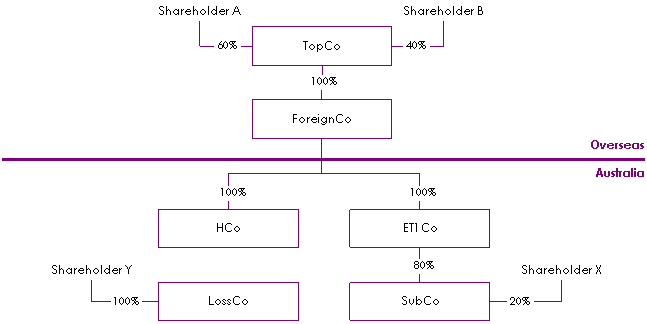
On 30 June 2002, the following events take place:
- •
- ET1Co purchases the remaining 20% of membership interests in SubCo from shareholder X, making SubCo a wholly-owned subsidiary of ET1Co, and
- •
- HCo purchases all the membership interests in LossCo from shareholder Y, making LossCo a wholly-owned subsidiary of HCo.
There are no other ownership changes in any of the companies up to 1 July 2002.
ET1Co and HCo are TopCo's first level of investment in Australia. TopCo meets the requirements to be a top company. ET1Co and HCo are eligible tier-1 companies and they form a MEC group on 1 July 2002, with HCo as head company. On 1 July 2002:
- •
- the net capital loss, incurred in the income year ended 30 June 2001 by SubCo, is transferred from SubCo to HCo under Subdivision 707-A as a COT transfer, and
- •
- the net capital loss incurred in the income year ended 30 June 2001 by LossCo, is transferred from LossCo to HCo under Subdivision 707-A because LossCo satisfies the same business test (SBT). [3]
Figure 2: MEC group at 1 July 2002

On 12 September 2002, shareholder C (an individual) purchases shareholder B's 40% interest in TopCo.
Figure 3: MEC group at 12 September 2002, after the sale of membership interests in TopCo
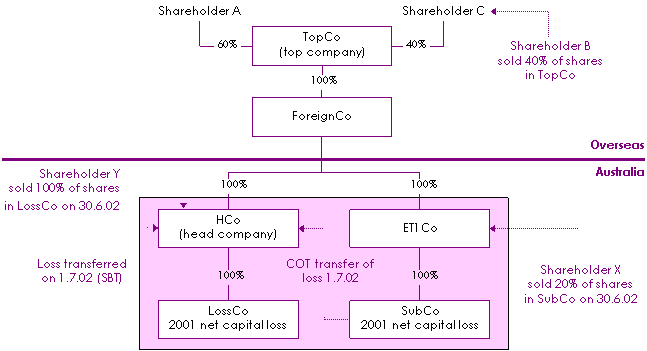
On 15 March 2003, BigtopCo, a foreign-resident company, purchases all of the membership interests in ForeignCo from TopCo. As a result, BigtopCo becomes top company of HCo's MEC group. [4]
BigtopCo's membership interests are owned by two individuals, shareholder D and shareholder E, who each have a 50% share.
HCo seeks to utilise both losses in the income year ended 30 June 2004 as the MEC group has made a capital gain in that year.
Figure 4: MEC group at 15 March 2003, after the sale of membership interests in ForeignCo
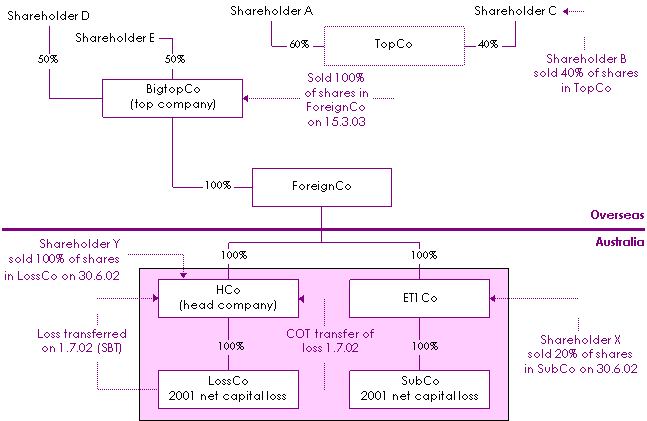
Figure 5: Timeline of events
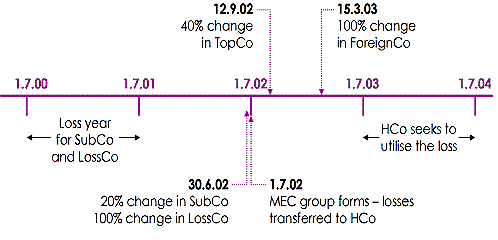
To determine whether HCo, as the focal company, satisfies the conditions in section 165-12 in relation to each of the losses, Subdivision 719-F must be applied.
Under section 719-260, the focal company is taken to have met the conditions in section 165-12 for the claim year (the year in which the focal company seeks to utilise the loss) and the loss, provided the test company identified in section 719-265 would have met the conditions for that year under:
- •
- section 719-270 (the test company makes the loss for an income year starting at a specified time)
- •
- section 719-275 (nothing happens to membership interests of specified entities if certain events take place), and
- •
- section 719-280 (the test company fails to meet the conditions in section 165-12 if certain events take place).
In other words, in relation to each loss, a test company must be identified under section 719-265. It is then necessary to determine whether the test company satisfies the COT in relation to the loss, based on the assumptions in sections 719-270, 719-275 and 719-280.
Calculation
The loss transferred from SubCo
Step 1: Identify the test company
Because the net capital loss was made by the focal company (HCo) as a result of a COT transfer, the table in subsection 719-265(2) is used to identify the test company in relation to the loss. Item 2 in the table applies because the focal company (HCo) and the transferor (SubCo) are different companies.
In accordance with paragraph 719-265(1)(b), section 719-265 is re-applied assuming the focal company is the transferor, SubCo. In this re-application, the table in subsection 719-265(4) applies as the loss was not transferred under Subdivision 707-A from a company to the (deemed) focal company (SubCo). Item 3 in the table identifies the test company as the (deemed) focal company, SubCo.
Step 2: Assume the test company made the loss
SubCo is therefore the test company in relation to HCo, the focal company. If SubCo satisfies the COT (based on the relevant assumptions) for the income year ended 30 June 2004 (the year in which HCo seeks to utilise the loss), then HCo is considered to satisfy the COT in relation to the loss for that year.
Step 3: Identify the start of the test company's loss year
Section 719-270 is used to determine the start of the income year in which SubCo is considered to have made the loss. Because SubCo is neither the top company of the MEC group, nor the focal company, nor the first head company, subsection 719-270(4) applies.
Item 1 in the table in subsection 719-270(4) identifies the start of the loss year as the start of the income year in which SubCo made the loss (i.e. 1 July 2000).
Step 4: Identify events that freeze the ownership structure
The focal company, HCo, seeks to utilise the loss in the income year ending on 30 June 2004. This means the period in which the events described in section 719-275 can trigger freezing of the ownership structure is from 1 July 2000 to 30 June 2004.
The COT transfer of the loss from SubCo to HCo on 1 July 2002, when the MEC group forms, is one of these triggering events → item 1 of the table, subsection 719-275(2). After this event, it is assumed that the ownership of SubCo and all entities interposed between SubCo and TopCo remains unchanged, for the purposes of determining whether SubCo satisfies the COT in relation to the loss. The only relevant ownership changes after this event are changes to the ownership of TopCo.
For the period 1 July 2000-30 June 2004, the only ownership changes that are relevant to determining whether SubCo satisfies the COT for the year ended 30 June 2004 are:
- •
- the change in SubCo's ownership on 30 June 2002 (when ET1Co purchases the remaining 20% membership interests in SubCo from shareholder X, making SubCo a wholly-owned subsidiary of ET1Co ), [5] and
- •
- the change in TopCo's ownership on 12 September 2002 (when shareholder C purchases the 40% membership interest in TopCo from shareholder B). [6]
The ownership change in ForeignCo is ignored because it occurs after the freezing of the ownership structure between SubCo and TopCo.
Figure 6: Freezing of ownership structure - examining SubCo's ownership
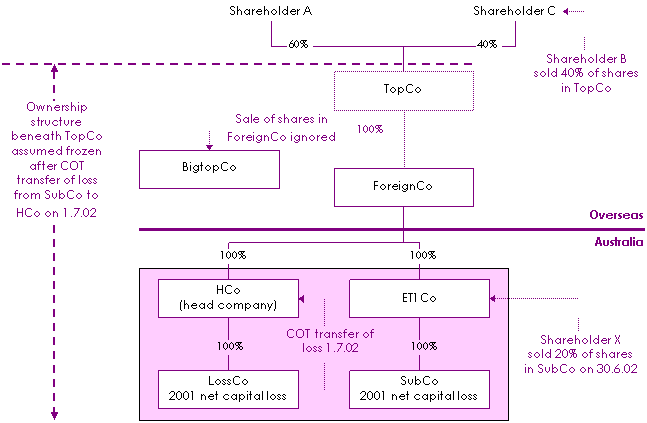
There is a 52% change in the underlying ownership of SubCo (the test company) on 12 September 2002 (compared to the start of the loss year). [7] This majority change in the ownership of SubCo means that SubCo does not meet the conditions in section 165-12 for the period 1 July 2000-30 June 2004.
Under subsection 719-260(2), the focal company (HCo) is considered to have failed to meet the conditions in section 165-12 on the first occasion that the test company (SubCo) fails to meet those conditions.
Step 5: Identify events that cause a deemed COT failure to occur
Section 719-280 must be applied to determine whether this is the first time SubCo fails to meet the conditions. (Section 719-280 applies as there is a change in the identity of the top company when BigtopCo takes over on 15 March 2003.)
Under subsection 719-280(3), the test company is considered to have failed to meet the conditions in section 165-12 [8] if:
- •
- the change in the identity of the top company results from changes in the membership interests of:
- -
- an eligible tier-1 company of the MEC group, or
- -
- an entity interposed between the eligible tier-1 company of a MEC group and the top company of the MEC group (just before the change in the membership interests), and
- •
- the change does not cause the potential MEC group to cease to exist. [9]
This means SubCo is considered to have failed the COT on 15 March 2003 under section 719-280. However, as this is later than the change in majority ownership of SubCo (12 September 2002), HCo is considered to have failed to meet the conditions in section 165-12 in relation to the loss transferred from SubCo on 12 September 2002.
For HCo to be able to utilise the loss in the income year ended 30 June 2004, it would need to satisfy the SBT (section 165-13) in relation to:
- •
- the business conducted in the income year ended 30 June 2004, and
- •
- the business conducted just before the time that HCo is considered to have failed to meet the conditions in section 165-12 (i.e. just before 12 September 2002).
The loss transferred from LossCo
Step 1: Identify the test company
As the net capital loss was transferred under Subdivision 707-A from Loss Co to the focal company (HCo) because LossCo satisfied the SBT, the table in subsection 719-265(3) is used to identify the test company in relation to the loss. Item 1 in the table applies because the focal company (HCo) was the head company of a MEC group at the time of the transfer. The test company is identified as the top company of the MEC group at the time of the transfer (in this case, TopCo).
Step 2: Assume the test company made the loss
If the test company, TopCo, satisfies the COT (based on the relevant assumptions) for the income year ended 30 June 2004 (the year in which HCo seeks to utilise the loss), then HCo is considered to have satisfied the COT in relation to the loss for that year.
Step 3: Identify the start of the test company's loss year
Section 719-270 is used to determine the start of the income year in which TopCo is considered to have made the loss. Subsection 719-270(1) applies because the test company (TopCo) is the top company of a MEC group and the focal company (HCo) is the head company of that group. Item 2 in the table in subsection 719-270(1) applies because the loss is transferred to the focal company (HCo) under Subdivision 707-A. TopCo is considered to have made the loss at the time of that transfer (i.e. in the income year starting 1 July 2002).
Step 4: Identify events that freeze the ownership structure
The focal company, HCo, seeks to utilise the loss in the income year ending 30 June 2004. This means the period in which the events described in section 719-275 can trigger freezing of the ownership structure is from 1 July 2002 to 30 June 2004.
In this instance, the focal company (HCo) is not the test company, but subsection 719-275(3) provides that, for the purposes of section 719-275, HCo is considered to have made the loss at the time the loss is transferred to it under Subdivision 707-A (1 July 2002).
When BigtopCo becomes the top company of the MEC group on 15 March 2003, this triggers the freezing of the ownership structure between TopCo and BigtopCo → item 3 of the table in subsection 719-275(2). However, because BigtopCo does not hold any direct or indirect ownership interest in TopCo, this will not affect whether TopCo satisfies the conditions in section 165-12.
For the period 1 July 2002-30 June 2004, the only ownership change that is relevant to determining whether TopCo satisfies the COT for the year ended 30 June 2004 is:
- •
- the change in TopCo's ownership on 12 September 2002 (when shareholder C purchases 40% of TopCo from shareholder B).
All other ownership changes are irrelevant because they do not involve a change in the underlying ownership of TopCo. As the majority ownership in TopCo does not change over the period, the company appears so far to have satisfied the conditions in section 165-12. However, before a final determination can be made, section 719-280 must also be considered because there is a change in the identity of the top company (when BigtopCo takes over on 15 March 2003).
Figure 7: Freezing of ownership structure - examining TopCo's ownership

Step 5: Identify events that cause a deemed COT failure to occur
Under subsection 719-280(3), the test company is considered to have failed to meet the conditions in section 165-12 if:
- •
- the change in the identity of the top company results from changes in the membership interests of:
- -
- an eligible tier-1 company of the MEC group, or
- -
- an entity interposed between the eligible tier-1 company of a MEC group and the top company of the MEC group (just before the change in the membership interests), and
- •
- this change does not cause the potential MEC group to cease to exist.
This means TopCo is considered to have failed to meet the conditions in section 165-12 on 15 March 2003 under section 719-280.
Under subsection 719-260(2), the focal company, HCo, is considered to have failed to meet a condition in section 165-12 on the first occasion that the test company, TopCo, fails to meet the condition. HCo therefore fails the COT in relation to the loss on 15 March 2003, when BigtopCo becomes the top company of the MEC group.
For HCo to be able to utilise the loss in the income year ended 30 June 2004, it needs to satisfy the SBT in relation to:
- •
- the business conducted in the income year ended 30 June 2004, and
- •
- the business conducted just before the time that HCo is considered to have failed to meet the conditions in section 165-12 (i.e. just before 15 March 2003).
References
Income Tax Assessment Act 1997:
- •
- sections 165-12, 165-13
- •
- paragraph 719-5(7)(b)
- •
- subsection 719-10(8)
- •
- section 719-140; as inserted by Tax Laws Amendment (2010 Measures No. 1) Act 2010 (No. 56 of 2010), Schedule 5, Part 2
Income Tax Assessment Act 1997 , Subdivision 719-F, subsection 707-210(1A); as amended by New Business Tax System (Consolidation and Other Measures) Act 2003 (No. 16 of 2003), Schedule 13
Explanatory Memorandum to the New Business Tax System (Consolidation and Other Measures) Bill (No. 2) 2002, Chapter 3
Income Tax Assessment Act 1997 , Subdivision 707-A; as amended by New Business Tax System (Consolidation) Act (No. 1) 2002 (No. 68 of 2002), Schedule 1
Tax Laws Amendment (2010 Measures No. 1) Act 2010, item 17
Explanatory Memorandum to the Tax Laws Amendment (2010 Measures No. 1) Bill 2010, Chapter 5
History
Revision history
Section C10-2-325 first published 28 May 2003.
Further revisions are described below.
| Date | Amendment | Reason |
|---|---|---|
| 6.5.11 | Addition of footnote p. 1 to reflect changes to group conversion provisions. | Legislative amendments. |
Current at 6 May 2011
A COT transfer of a loss is defined in subsection 707-210(1A) as a transfer of a loss from a company that occurs because:
- •
- the transferor meets the conditions in section 165-12, and
- •
- none of the conditions in paragraphs 165-15(1)(a), (b) and (c) apply to the transferor.
Subdivision 719-F does not apply if the MEC group has converted to a consolidated group during the ownership test period, where the conversion took place:
- •
- on or after 27 October 2006, or
- •
- before 27 October 2006 and a choice in writing is made within the prescribed time for Subdivision 719-BA to apply from 1 July 2002.
LossCo experiences a change in its majority ownership on 30 June 2002 and is therefore unable to satisfy the COT as a transfer test. As the loss is made for an income year starting after 30 June 1999, the modified SBT in section 707-125 determines whether the loss can be transferred to HCo.
The MEC group continues to exist. Although the identity of the top company changes, the eligible tier-1 companies of the MEC group do not become members of another MEC group immediately after the change (therefore paragraph 719-5(7)(b) does not apply).
This ownership change occurs before the COT transfer of the loss from SubCo to HCo triggers the freezing of the ownership structure.
This ownership change occurs above the frozen part of the ownership structure.
Calculated as 20% + (40% x 80%). Based on the ownership structure in Figure 6, the only continuing underlying shareholder is shareholder A, who has held a continuous indirect interest in SubCo of 48% (i.e. 60% x 80%) since 1 July 2000.
Subsection 719-280(1) states that the test company is considered to have failed to meet the conditions in section 165-12 if any of the events described in subsections 719-280(2), (3) or (4) occurs.
Under subsection 719-10(8), a potential MEC group continues to exist after a change in the identity of the top company provided the same eligible tier-1 companies are members of the group immediately before and after the change.
